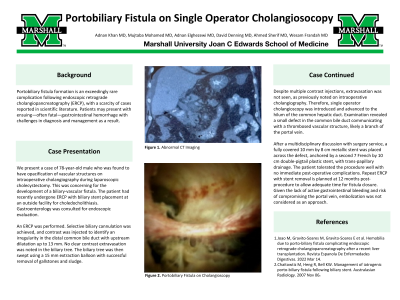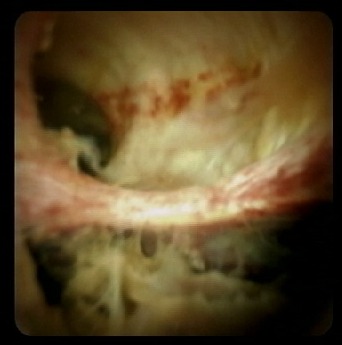Back


Poster Session E - Tuesday Afternoon
Category: Biliary/Pancreas
E0026 - Portobiliary Fistula on Single Operator Cholangioscopy
Tuesday, October 25, 2022
3:00 PM – 5:00 PM ET
Location: Crown Ballroom

Has Audio
- AK
Adnan Khan, MD
Marshall University Joan C. Edwards School of Medicine
Huntington, WV
Presenting Author(s)
Adnan Aman Khan, MD, Mujtaba Mohamed, MD, Adnan Elghezewi, MD, David Denning, MD, Ahmed Sherif, MD, Wesam Frandah, MD
Marshall University Joan C. Edwards School of Medicine, Huntington, WV
Introduction: Portobiliary fistula formation is an exceedingly rare complication following endoscopic retrograde cholangiopancreatography (ERCP), with a scarcity of cases reported in scientific literature. Patients may present with ensuing—often fatal—gastrointestinal hemorrhage with challenges in diagnosis and management as a result.
Case Description/Methods: We present a case of 78-year-old male who was found to have opacification of vascular structures on intraoperative cholangiography during laparoscopic cholecystectomy. This was concerning for the development of a biliary-vascular fistula. The patient had recently undergone ERCP with biliary stent placement at an outside facility for choledocholithiasis. Gastroenterology was consulted for endoscopic evaluation.
An ERCP was performed. Selective biliary cannulation was achieved, and contrast was injected to identify an irregularity in the distal common bile duct with upstream dilatation up to 13 mm. No clear contrast extravasation was noted in the biliary tree. The biliary tree was then swept using a 15 mm extraction balloon with successful removal of gallstones and sludge.
Despite multiple contrast injections, extravasation was not seen, as previously noted on intraoperative cholangiography. Therefore, single operator cholangioscopy was introduced and advanced to the hilum of the common hepatic duct. Examination revealed a small defect in the common bile duct communicating with a thrombosed vascular structure, likely a branch of the portal vein.
After a multidisciplinary discussion with surgery service, a fully covered 10 mm by 8 cm metallic stent was placed across the defect, anchored by a second 7 French by 10 cm double-pigtail plastic stent, with trans-papillary drainage.
Discussion: We present a novel approach for the identification and management of portobiliary fistulas. Our case demonstrates the utility of biliary stents in the management of this disease. Our patient tolerated the procedure well with no post-operative complications.

Disclosures:
Adnan Aman Khan, MD, Mujtaba Mohamed, MD, Adnan Elghezewi, MD, David Denning, MD, Ahmed Sherif, MD, Wesam Frandah, MD. E0026 - Portobiliary Fistula on Single Operator Cholangioscopy, ACG 2022 Annual Scientific Meeting Abstracts. Charlotte, NC: American College of Gastroenterology.
Marshall University Joan C. Edwards School of Medicine, Huntington, WV
Introduction: Portobiliary fistula formation is an exceedingly rare complication following endoscopic retrograde cholangiopancreatography (ERCP), with a scarcity of cases reported in scientific literature. Patients may present with ensuing—often fatal—gastrointestinal hemorrhage with challenges in diagnosis and management as a result.
Case Description/Methods: We present a case of 78-year-old male who was found to have opacification of vascular structures on intraoperative cholangiography during laparoscopic cholecystectomy. This was concerning for the development of a biliary-vascular fistula. The patient had recently undergone ERCP with biliary stent placement at an outside facility for choledocholithiasis. Gastroenterology was consulted for endoscopic evaluation.
An ERCP was performed. Selective biliary cannulation was achieved, and contrast was injected to identify an irregularity in the distal common bile duct with upstream dilatation up to 13 mm. No clear contrast extravasation was noted in the biliary tree. The biliary tree was then swept using a 15 mm extraction balloon with successful removal of gallstones and sludge.
Despite multiple contrast injections, extravasation was not seen, as previously noted on intraoperative cholangiography. Therefore, single operator cholangioscopy was introduced and advanced to the hilum of the common hepatic duct. Examination revealed a small defect in the common bile duct communicating with a thrombosed vascular structure, likely a branch of the portal vein.
After a multidisciplinary discussion with surgery service, a fully covered 10 mm by 8 cm metallic stent was placed across the defect, anchored by a second 7 French by 10 cm double-pigtail plastic stent, with trans-papillary drainage.
Discussion: We present a novel approach for the identification and management of portobiliary fistulas. Our case demonstrates the utility of biliary stents in the management of this disease. Our patient tolerated the procedure well with no post-operative complications.

Figure: Portobiliary Fistula on Single Operator Cholangioscopy
Disclosures:
Adnan Aman Khan indicated no relevant financial relationships.
Mujtaba Mohamed indicated no relevant financial relationships.
Adnan Elghezewi indicated no relevant financial relationships.
David Denning indicated no relevant financial relationships.
Ahmed Sherif indicated no relevant financial relationships.
Wesam Frandah: Endo gastric solution – Consultant. Olympus – Consultant.
Adnan Aman Khan, MD, Mujtaba Mohamed, MD, Adnan Elghezewi, MD, David Denning, MD, Ahmed Sherif, MD, Wesam Frandah, MD. E0026 - Portobiliary Fistula on Single Operator Cholangioscopy, ACG 2022 Annual Scientific Meeting Abstracts. Charlotte, NC: American College of Gastroenterology.
